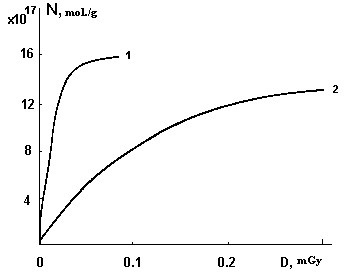
Radiation-stimulated adsorption processes on the surface of beryllium oxide
Abstract
The paper presents the study results of photo and gamma radiation effect on the beryllium oxide (BeO) surface properties. Photoadsorption studies of О2 on BeO by the methods of infrared (IR) spectroscopy and manometry with a change in the temperature of preliminary annealing from 473 to 1073 K show that samples subjected to preliminary training at 473 K are most active. The maximum of adsorption activity on g-irradiated beryllium oxide is observed on the samples annealed at 673 K before the irradiation. The maximum of paramagnetic centers (PMCs) is also observed on samples annealed at this temperature. Comparison of electron paramagnetic resonance (EPR) and adsorption studies shows that absorption of H2 and O2 leads to the destruction of paramagnetic centers. It is assumed that, upon irradiation, adsorption centers with electron and hole modes are formed on the surface of BeO.
Keywords
Full Text:
PDFReferences
Kiyko VS, Vaispapir VY. Production features of preparation and properties of ceramic objects made from a mixture of lightlyand highly-fired BeO powder. Refract Ind Ceram. 2016;57(4):423–426. doi:10.1007/s11148-016-9997-3
Gaft M, Nagli L, Gorychev A, et.al. Atomic and molecular emission of beryllium by LIBS. Spectrochim Acta Part B: Atomic Spectrosc. 2021;182:106233. doi:10.1016/j.sab.2021.106233
Wroblewska M, Blanchet D, Lyoussi A, et.al. A review and analysis of the state of the art on beryllium poisoning in research reactors. Ann Nucl Energy. 2021;163:108540. doi:10.1016/j.anucene.2021.108540
Zaripov RR, Nazarov AA, Ponikarov SI. Catalysts applied in the catalytic dehydrogenation of hydrocarbons. Bull Kazan Technol Univ. 2013;16:67–75. Available from: https://cyberleninka.ru/article/n/katalizatory-primenyaemye-pri-kataliticheskom-degidrirovanii-parafinovyh-olefinovyh-i-alkilaromaticheskih-uglevodorodov
Dey S, Drazin J, Wang Y, et.al. Radiation tolerance of nanocrystalline ceramics: insights from yttria stabilized zirconia. Sci Rep. 2013;7746. doi:10.1038/srep07746
Du JH, Peng L. Recent progress in investigations of surface structure and properties of solid oxide materials with nuclear magnetic resonance spectroscopy. Chin Chem Lett. 2018;29(6):747–751. doi:10.1016/j.cclet.2018.02.012
Was GS. Fundamentals of radiation materials science. USA, New York: Springer. 2017. doi:10.1007/978-1-4939-3438-6
Petrik NG, Alexandrov AB, Orlando TM, Vall AI. Radiation-induced processes at oxide surfaces and interfaces relevant to spent nuclear fuel storage. Am Nucl Soc Winter Meet, Long Beach, CA, United States. 1999.
Zinkle SJ, Was GS. Materials challenges in nuclear energy. Acta Materialia. 2013;61(3):735–758. doi:10.1016/j.actamat.2012.11.004
Rollett D, Wang Y, Carpenter JS. Design of radiation tolerant materials via interface engineering. Adv. Mater. 2013;25:6975–6979.
Polushin NI, Laptev AI, Spitsyn BV. Deposition of boron-doped thin CVD diamond films from methane-triethyl borate-hydrogen gas mixture. Process. 2020;8(6):666. doi:10.3390/PR8060666
Tuseyev T, Polyakov A, Bitenbaev M. About kinetics of detect accumulation in irradiated oxides of metals. Eurasia Conf Nuclear Sci Appl, Izmir Turkey. 2000.
Tuseev T. Study of the surface properties of irradiated oxide materials. 6th Int Conf "Nuclear and Radiation Physics", Almaty, Republic of Kazakhstan. 2016.
Tuseyev T. Radiation effects on oxide material surface. 5th Conf “Nuclear Science and Its Application”, Ankara, Turkey. 2008.
Altunal V, Guckan V, Ozdemir A, et.al. A calcination study on BeO ceramics for radiation dosimetry. Mater Res Bull. 2020;130. doi:10.1016/j.materresbull.2020.110921
Ryskulov AE, Kozlovskiy AL, Ivanov IA, et.al. The effect of Ni12+ heavy ion irradiation on the optical and structural properties of BeO ceramics. Ceram Int. 2020;46(4):4065–4070. doi:10.1016/j.ceramint.2019.02.121
Khromushin IV, Aksenova TI, Tuseev T, et.al. Particularities of radiation defect formation in ceramic barium cerate. IOP Conf Ser: Mater Sci Eng. 2015;81(1):012037. doi:10.1088/1757-899X/81/1/012037
Védrine JC. Heterogeneous catalysis on metal oxides. Catal. 2017;7:341. doi:10.3390/catal7110341
Mishra SK, Ahlawat A, Khosla D, et.al. Experimental investigation of variations in morphology, composition and mixing-state of boundary layer aerosol: A balloon based study over urban environment (New Delhi). Atmos Environ. 2018;185:243–252. doi:10.1016/j.atmosenv.2018.04.053
Martynova TV, Kirichenko AN, Shitareva MS. Fourier-transform infrared spectroscopy for analysis of diamond materials of different origin. IOP Conf Ser: Mater Sci Eng. 2021;1047(1):012187. doi:10.1088/1757-899X/1047/1/012187
Altunal V, Guckan V, Ozdemir A, et.al. A systematic study on luminescence characterization of lanthanide-doped BeO ceramic dosimeters. J Alloy Compd. 2021;876:160105. doi:10.1016/j.jallcom.2021.160105
Maslov AL, Laptev AI, Polushin NI. Express-analysis of nitrogen content in CVD-diamonds by FTIR-spectrometry. IOP Conf Ser: Mater Sci Eng. 2020;919(2):022049. doi:10.1088/1757-899X/919/2/022049
Milisch B, Kerbe F, Michalowsky L. Defect centres in beryllium oxide ceramics studied by electron paramagnetic resonance (EPR). Ceram Int. 2016;16(5):311–318. doi:10.1016/0272-8842(90)90045-H
Fang W, Yang DX, Chen HJ, et.al. Investigations of the electron paramagnetic resonance parameters and defect structures for Cu2+ ions in BeO crystal with trigonally distorted tetrahedral symmetry. Mater. 2019;475:234–239. doi:10.1016/j.jmmm.2018.11.081
DOI: https://doi.org/10.15826/chimtech.2022.9.1.06
Copyright (c) 2021 Turgara T. Tusseyev, Aktolkyn K. Danlybaeva, Saltanat S. Raimkul, Aizhan A. Kiykabaeva, Ospan M. Doszhanov

This work is licensed under a Creative Commons Attribution 4.0 International License.
Chimica Techno Acta, 2014–2025
eISSN 2411-1414
Copyright Notice






